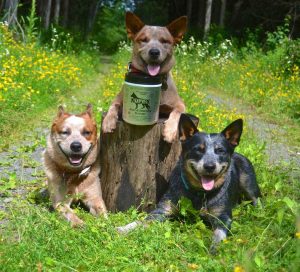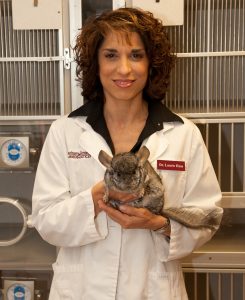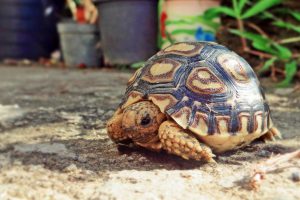Senior Pets and their Specialized Products
Alexandra Wepner //November 15, 2017//
Though all pets age, there is a great deal of variety across the lifespans of popular domesticated species. For example, hamsters can survive between one and three years, depending on the breed. Toward the other end of the spectrum, certain reptilian species, like turtles and tortoises, can live up to 40 to 60 years.
Of course, it’s important for retailers to speak with potential pet owners about the commitment they’re making in owning their desired pet. And once those pets do reach an elderly age, some may require specialized care and support. However, by most accounts, it’s never too early to begin laying the foundation for a long and healthy life.
Old Dog, New Tricks
According to the 2017-2018 APPA National Pet Owner’s Survey, the average age of a dog owned in the U.S. is 6.7 human years. When counted by generation, it’s unsurprising that older owners (baby boomers and builders) have dogs older than 7 years old on average.
“It’s around age 7 [that dogs] move into that senior stage and a dog’s glucose metabolism in the brain begins to change,” said Dr. Kurt Venator, chief veterinary officer at Nestlé Purina. “And this can affect memory, learning, awareness or decision making… [The] normal energy source that those brain cells would use is glucose, and so they become less effective at metabolizing glucose, which means less effective at providing energy for these brain cells.”
Signs of such changes, according to Dr. Venator, could include decreased activity and playfulness, disinterest in interaction with owners or other dogs and more difficulty learning. He says that Purina’s Pro Plan Bright Mind formula can enhance older dogs’ interactions, interest in play and ability to adapt and cope with change because the food provides enhanced botanical oils, which can be used as an alternative energy source for the brain cells. Bright Mind “includes a blend of brain-supporting nutrients for cognitive health,” as well as omega-3 and omega-6 fatty acids, glucosamine and Vitamin A, according to the company’s website.
“We’re learning so much more, and companies are doing such great science around optimal health at different life stages,” said Dr. Venator, adding that owners have reported a visible improvement within 30 days of feeding with Bright Mind. “Part of this is to help educate pet owners that if they want their pet to have optimal health and to thrive, we do need to be aware of these [cognitive] changes, subtle as they may be, so that we can address them.”
While Bright Mind primarily targets brain function, Vet Vittles supplements are made with herbal ingredients for a natural way to s upport other parts of an aging pet’s body. For pet owners looking for an alternative to pharmaceuticals—and market trends indicate that more pet owners are doing so, as Packaged Facts analysts estimated that natural pet food sales reached $8.2 billion in 2016— there’s Vet Vittles, which feature nutraceuticals, a “food or food product, typically derived from a natural source, which has health and medical benefits,” according to the company’s website.
upport other parts of an aging pet’s body. For pet owners looking for an alternative to pharmaceuticals—and market trends indicate that more pet owners are doing so, as Packaged Facts analysts estimated that natural pet food sales reached $8.2 billion in 2016— there’s Vet Vittles, which feature nutraceuticals, a “food or food product, typically derived from a natural source, which has health and medical benefits,” according to the company’s website.
“In nature, there is one more way [other than pharmaceuticals] to treat a disease without high cost (dangerous side effects),” Dr. Felix Gurman of Vet Vittles said. “Instead of purified pharmaceuticals, real animals (and humans), led by taste and instinct, consumed multi-compositional things and these thousands of ingredients played their role in treatment mutually… This way provides an opportunity to neglect costly side effects and provide smooth treatment of health deviation.”
According to Dr. Gurman, Vet Vittles products are made with powders of whole parts of well-known medicinal plants, including leaves, roots, flowers and bark. Customers can find more information about each product’s ingredients on the label.
“[Aging Paw is an] herbal supplement that incorporates more than a dozen different herbs which are known for their positive effects on different organs that might be weakened while aging,” Dr. Gurman said. “[The] Aging Paw formula boosts vitality, sharpens the brain, improves blood circulation, levels blood sugar and supports pancreas functions, digestion and joints.”
He also mentioned PowerMune and Liver Support, all of which target the “most vulnerable functions in old age,” including joints, blood circulation, digestion and the urinary system. The company produces supplements for dogs and cats at various life stages.
Based in Naples, Florida, Ark Naturals has a line of products dedicated specifically to the mental and physical health of senior pets. In addition to soft chews targeting brain, heart and joint health (the latter in two varieties, one of which is maximum strength for larger breeds), the Gray Muzzle line includes a No Shampoo! Shampoo for dogs that have difficulty standing.
“Gray Muzzle’s rinseless, waterless foam shampoo gently cleans your pet without all of the hassle of bath time,” the company states on its website. “[The] natural botanical formula cleans and moisturizes pets’ coats.”
Ark Naturals also offers a Gray Muzzle Brushless Toothpaste, which is a “senior-friendly” dental chewable that controls plaque, tartar and bad breath. It’s particularly useful for dogs with gum tenderness or missing teeth.
Keeping Kitty Witty
Estimating the age of cats in human years is a bit more complicated than commonly thought (as is the case with dogs, for which size is among one factor that affects the calculation of their age). According to the Cornell Feline Health Center, “a 1-year-old cat is physiologically similar to a 16-year-old human, and a 2-year-old cat is like a person of 21. For every year thereafter, each cat year is worth about four human years.”
The center estimates that many cats enter a “senior stage” by the time they reach 7 to 10 years of age, perhaps 12 years old at the latest. Janis Gianforte, president of Nupro, believes that a well-supplemented diet can help cats lead longer, healthier lives.
“Cats, just like dogs, need supplementation, too,” said Gianforte, whose Nupro makes supplements for dogs, cats and ferrets. “Many cat owners don’t think about that because cats sleep way more than dogs do and they don’t have the same stresses as dogs and don’t show serious health prob
lems usually until it’s too late to really be able to help.”
Nupro’s Health Nuggets for Cats provide pets with raw vitamins, minerals, enzymes, amino acids and omega fatty acids that “may be lacking in commercially processed cat foods,” according to the company’s website. The product can be added to wet or dry cat food or crushed and mixed with water to create a gravy.
“When you add real, unprocessed ingredients to your pets’ diet, it’s a tremendous bonus,” she continued. “Amino acids and enzymes are needed for a healthier life. That, in most cases, equals longevity.”
Gianforte also pointed to the important role that flexible joints and pain prevention play in senior pets’ quality of life. These pets can stay active further into old age, helping them to feel better and prevent weight gain. For dogs, Nupro makes a joint and immunity supplement, as well as a Custom Electrolyte Formula for dogs, made specifically for highly active “working” or “performance dogs,” according to the product’s description.
Ultimately, though, Gianforte stresses the importance of preventative care and nutrition and that retailers have the important power of educating their customers.
“Retailers need to know and understand about the many holistic products on the market today,” Gianforte said. “Treating the dog and cat early in life with good, natural, holistic ingredients may help prevent issues that occur with age later in life. Prevention is key.”
Feathers and Fur
Dr. Laurie Hess, DVM, Diplomate ABVP, owner and medical director of the Veterinary Center for Birds and Exotics, specializes in the care of avian and exotic pets. She cites diet, exercise and preventative care as important factors to a pet’s longevity.
“[Birds] change very much like us, particularly some of the larger birds that live longer,” said Dr. Hess, who also serves as ZuPreem’s director of Pet Health and Nutrition. “Som etimes it’s harder for birds to climb around their cages and get access to toys and other food.”
etimes it’s harder for birds to climb around their cages and get access to toys and other food.”
Dr. Hess counted atherosclerosis (hardening of the arteries with cholesterol deposits), heart attacks and strokes as some of the most common ailments she’s witnessed in avian patients. She also cites obesity, which can cause joint issues and arthritis.
“It goes back to the diet in some way,” she noted. “Vitamin A is very critical to the health of the kidneys, among other organs, and we see a lot of gout or kidney failure… Things that happen in people happen in birds, too.”
For small animals, Dr. Hess also cites diet and lack of activity as the primary source of issues as small animals become older.
“They’re not outside getting fresh air and sunshine,” Dr. Hess said. “With birds in particular, sunshine is very important to making Vitamin D in their skin… With small animals, we don’t give them the variety in their diet. When they’re outside, they’re eating a lot of grass, they’re eating a lot of hay and roughage like that.”
Dr. Hess recommends birds be placed on pelleted diets to keep them healthy into old age, supplementing that diet with small amounts of fruits, vegetables and treats in moderation. They also need exercise, artificial light and calcium supplements. ZuPreem makes several pelleted diets, variety blends and treat mixes, and provides a helpful guide to a bird’s balanced diet on their website.
For small animals, hay is an important part of their diet, as is a Vitamin C supplement (Dr. Hess recommends going further than water additives, providing a tablet or liquid). ZuPreem produces Nature’s Promise Western Timothy Hay as well as pelleted high-fiber diets formulated with Vitamin C for rabbits, guinea pigs and chinchillas. Oxbow also makes a tableted Vitamin C supplement for small animals. And specifically for ferrets, Nupro makes a dietary supplement.
“All pets benefit from a diet that goes beyond dry or canned food, so a good supplementation program is just as necessary [for ferrets],” Gianforte said. “Ferrets also need a good supplement because they are prone to health issues as well and, as stated before, prevention is the key. Our products support a healthy immune system and digestion, and contain fatty acids for great skin and coat.”
And of course, regular preventative care is important for all species.
“Don’t wait until your animal is really sick to bring it to the veterinarian,” Dr. Hess said. “The same way you bring your dog or cat in for a check-up every year, bring your bird, your guinea pig. Bring your bunny in for a check-up because we catch a lot of those diseases before they become really apparent.
“Remember those animals are prey species so they’re trained to hide their signs until they’re really sick and by the time the owner notices, there’s usually a really big problem. Sometimes it’s not treatable at that point.”
Resilient Reptiles
Unlike such is the case for elderly dogs, cats, small animals and birds, aging reptiles tend to show few obvious changes as they age, and experts like Loren Leigh, owner of LLLReptile and Supply Company, say that reptile care changes little as the pet ages. In an article written for PetPlace.com, Dr. Dawn Ruben of the University of Missouri College of Veterinary Medicine writes that chameleons are typically the shortest-lived reptiles, surviving between one and three years in captivity. Many reptiles can live for decades, such as geckos (into their 20s), snakes (15 to 30 years) and, as mentioned, turtles and tortoises (40-60 years).
“One big change that we see is behavior, as animals become more mellow and docile in time,” said Leigh, pointing out that aging reptiles make great pets with more frequent handling and interaction and familiarity with their space. According to Leigh, the care and diet of a reptile changes  little as the pet grows older, with some exceptions such as with tortoises or lizards, who might need a different feeding approach as they get larger.
little as the pet grows older, with some exceptions such as with tortoises or lizards, who might need a different feeding approach as they get larger.
However, that’s not to say that the reptile category has seen zero innovation, and these developments are important to pet reptiles leading long and healthy lives.
“The only area that has advanced has really been in probiotics (Zilla and Nature Zone make a line of these products), healing agents (Vetericyn) [and] better calcium and multivitamins developed for different stages of the life cycle of reptiles (Repashy Ventures),” Leigh said.
As for care, Leigh says that most practices that retailers could recommend to their customers are applicable to reptiles of all ages. As reptiles grow older, the lethargic pets might be up for less handling. Cage design is one area of concern as well. Retailers should remind their customers to make sure pieces of wood or other accessories are stable as to not injure their pet. Frequent cage cleaning and using hand cleaners before handling older reptiles will protect them from picking up bacteria to which they may grow increasingly susceptible.
“Making sure you are using the proper calcium and lighting from day one will only increase a reptile’s life span and overall quality of life,” said Leigh, also citing more varied food options. “Timberline with Vita-Bugs, for example, has changed the way a cricket is looked at as a nutritional food for reptiles. Fruit flies, silkworms, goliath worms and roaches [give] an ever-increasing array of options… Animals once considered impossible to keep with a life span of three to four years are commonplace now with life spans of eight to 10 years.”



















